The Buyer’s Guide to PR and Corp Comms Software
Everything you need to know before choosing a CommTech vendor
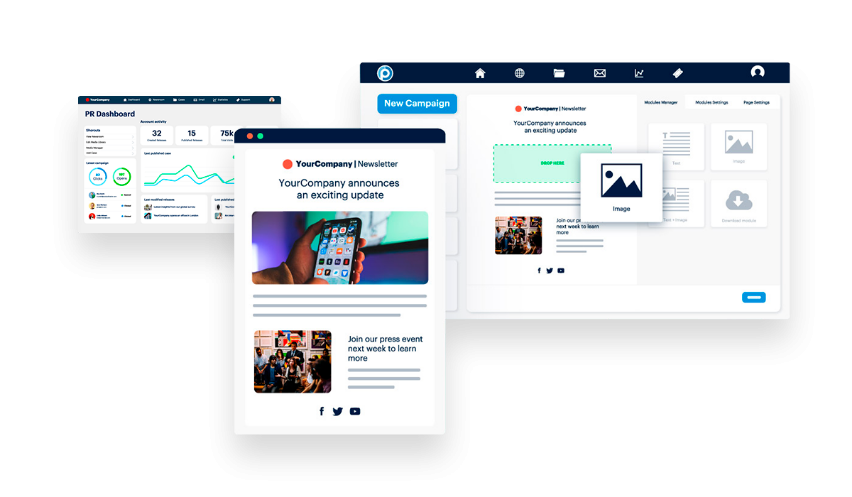
How many pieces of software did it take to run your last Public Relations campaign?
For many teams, a single campaign can involve any number of tools: spreadsheets buried on a server with journalists’ details; folders somewhere in the cloud with the right images; a CRM to send press releases out; an analytics tool to monitor performance. It’s overwhelming, it’s inefficient, and many Public Relations teams are looking for a better solution. Often, this comes in the form of PR software.
With increasingly fast-paced news cycles, the challenges of remote work taking hold, and the urgent need to inform campaigns with data, it’s becoming clear that these gaps in the PR workflow slow down the process of getting your company’s news out.
Where do you even start if your company has decided to address these gaps? This guide goes through the advantages of using PR software and will help you with some of the most important features you should be looking for in the process of choosing one, including newsroom software, PR distribution, media monitoring, and analytics.
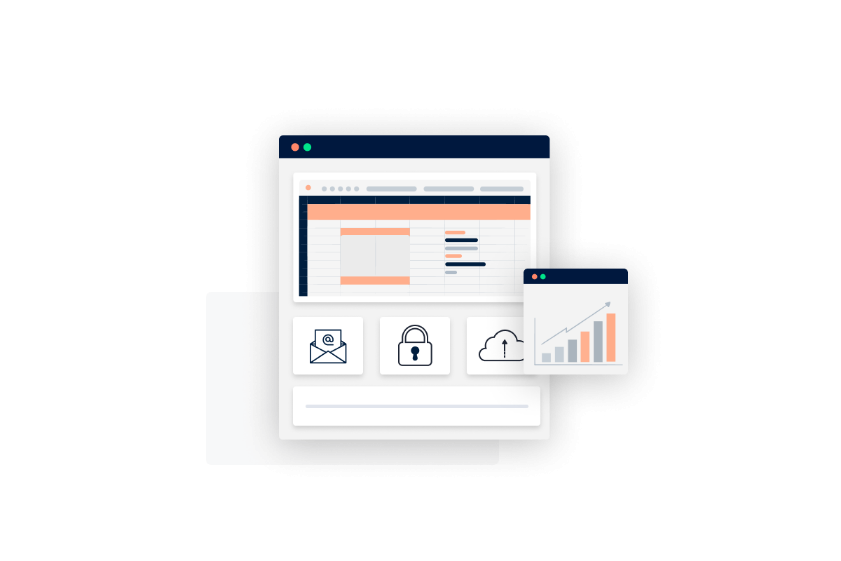
Why invest in CommTech?
For forward-thinking companies the role of the newsroom has changed in recent years. PR Specialists have become multimedia journalists; hosting podcasts and YouTube tv shows; creating libraries of crisp photography instead of relying on stock images, and redefining content through thought leadership.
The right software comes with a distribution software guide that can help you create a seamless, end-to-end Corp Comms campaign that makes an impact. Create well-designed content, find the right people to send it to, distribute it, and monitor the results all in one place. Eliminating time (and budget)-consuming processes and streamlining your work through reporting software that keeps everything you need in one place frees up your team’s time so they can spend it on what they do best – creating awesome campaigns.
For most brands, the crucial must-haves in a PR software or CommTech solution are that it is easy to use, secure, scalable, stable, and compliant with local legislation – like GDPR in the EU. Here, we cover every part of the Corp Comms workflow and how software can help. The right platform will have comprehensive features for each stage of the workflow.
We also have a full list of features you should be on the lookout for here.
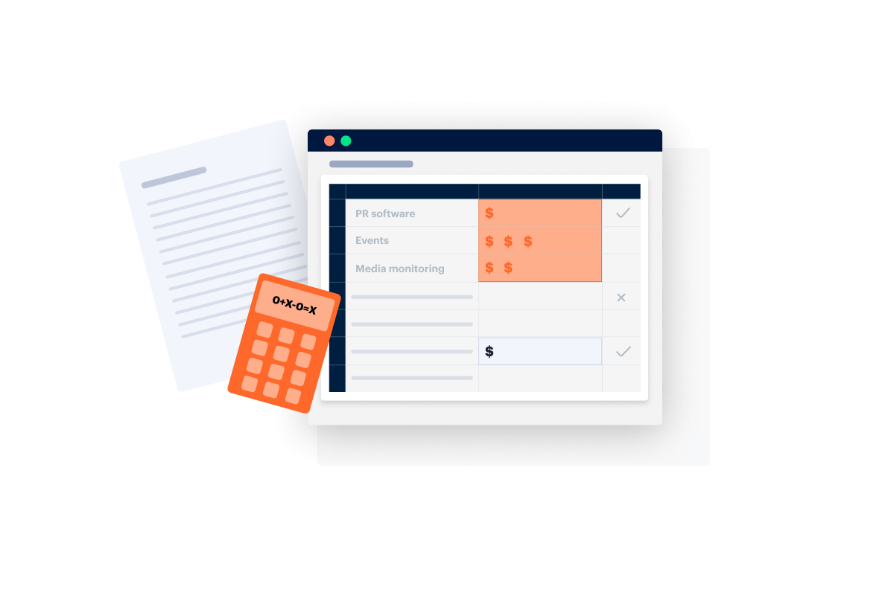
1
Buying online newsroom software
Newsrooms are a hugely impactful tool, they act as a communications hub, letting you showcase your own stories and provide multimedia content on your own terms. Our PR distribution software guide will give you an idea of how to provide press releases, videos, image galleries, links to social media, and anything else you might need to bring a story to life. If you’re looking to make the most of your newsroom, chances are you have two choices: to build one in-house or to buy the PR reporting software from a vendor and integrate it into your website. Building it is likely to be an expensive, complex, and time-consuming project, so for this guide, we’ll talk about what to look for when seeking out software from a vendor.
- Intuitive and user-friendly Content Management System (CMS): your team should be able to create a vibrant, interactive space where journalists, investors, potential employees, and members of the public can be introduced to all the most exciting and interesting things your company is working on. A CMS ensures that content is published quickly and easily. The newsroom should also support an array of content formats; newsletters; podcasts; video; infographics and more.
- Integration and branding: Most large organizations have strict brand guidelines, so you might want to pay special attention to this one. Consistency is crucial and the newsroom should flow seamlessly from the rest of the site and should be visually indistinguishable, this is part of the importance of a PR reporting software. A newsroom should look, feel and operate like the rest of the site. This includes everything from navigation to logos, button styles, type sizes, page frame, and all other graphic elements.
- Adaptability: Producing content for journalists is very different from creating content for customers, end-users, or investors. If you’ve got multiple audiences, make sure that your newsroom adapts to the way they get their information. Navigation should easily allow visitors to access the content most relevant to them.
- Interactive options: Direct feedback from stakeholders can be extremely useful, so look out for software that offer forms, polls, subscription boxes, and comment sections. Creating a two-way stream of information keeps visitors engaged and can help you stay in touch with them in many different ways.
- Good UX: UX or User Experience is all about making sure that whatever you’re creating meets the user’s needs with no fuss. In a newsroom, this might also mean a proper categorization or labeling system powered by a PR reporting software so that content that fits into a particular topic can easily be found; the chance to create media libraries where people can find images and videos easily; press kits that give a part of your audience everything they need to know about your company; and a well-placed search box.
- SEO: There are quite a few considerations for Search Engine Optimization (SEO), which informs where your company’s website ranks in Google. Our PR distribution software guide discusses how an optimized newsroom can help your whole site rank more highly against competitors, and ensure your site is easily found. Your press releases in particular contribute to how easy your content is to find in search results so when looking for a vendor, it’s important to look at the technical side of SEO and how it’s set up in a newsroom platform.
- Sitemaps: site maps are an overview of the pages on your site. They are particularly helpful with larger sites with lots of content. In a nutshell – make sure the tool you choose automatically generates a sitemap and can update it regularly.
- Meta information: Adding and editing meta titles or descriptions and defining the URL that best describes your content helps your site gain authority in the “eyes” of search engines. In a lot of content management systems, it’s possible to do this when editing content.
- Social media: One of the major changes in PR over the last number of years is the move towards channels businesses can control directly. A strong social media presence can hugely amplify the reach of your stories. Easy social sharing and distribution is a must for any newsroom, as are embedded social feeds in some cases.
- Language support: Many global companies release their biggest news in multiple languages to reach audiences in different parts of the world. Choosing a PR reporting software that also makes it easy to upload content in several languages and allows users to navigate easily to the language of their choice.
The right software can transform your relationship with your stakeholders; it can help you engage directly with your audiences, particularly journalists or other media stakeholders who might be looking for information about your brand – from the latest news about a recent investment round to providing the right background information like your boilerplate, press kit, or product videos.
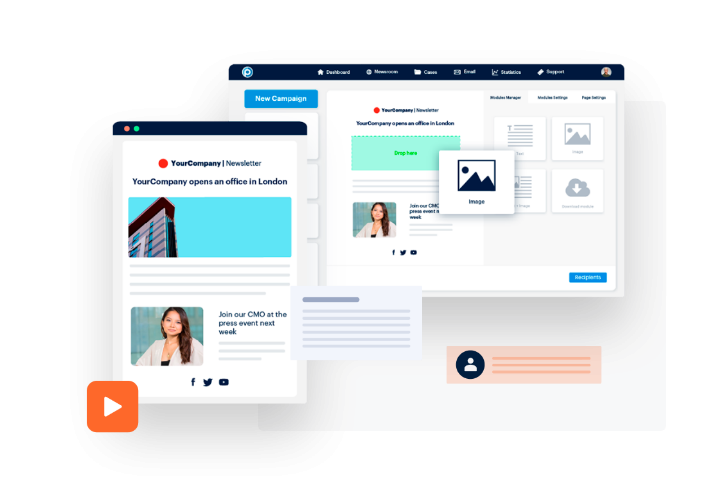
2
Sophisticated Publishing & Distribution tools
When your team spends a lot of time creating a piece of content, whether it’s a press release, a new video explainer, a piece of thought leadership, or a podcast, it makes sense that you want it to have as wide a reach as possible. It’s important that all the hard work pays off. The right PR distribution tool with a PR distribution software guide will help you get the message out to the right people.
The integrated email distribution workflow means everything is in the same place: contact information, email campaign builder, assets that you can easily share, and campaign analytics, making the process faster and more coherent. No more searching for long-lost files or trying to find images on the server or in the cloud.
- Email distribution: Good email distribution tools are key to successful PR software. Most tools will let you create different types of emails, from press releases to newsletters, and design them elegantly. Your emails should be on-brand, so look for something that allows you to work on a template. Text-only campaigns also tend to be less engaging than campaigns that include images, releases, or videos – make sure to choose a tool that lets you embed several content formats. It’s also essential that you abide by international laws on privacy and data protection, and the right software will facilitate that.
- Contact management: One of the most common things we see is that many people keep their contacts in a spreadsheet. This can result in high bounce rates, lists quickly become outdated as journalists move from one organization to another. A good CRM makes contact management easier by simplifying the upkeep of your lists. This saves an enormous amount of time a PR team might otherwise spend tracking down these contacts and then keeping them up to date on a separate spreadsheet. Make sure that the tool you choose has a PR distribution software guide and will let you create several lists and segment them based on criteria like sector, location, and type of publication so that you can easily reach journalists in your target demographic.
- Media lists: Unlike newswires, tailored and up-to-date media lists created through your PR reporting software allow you to build a relationship with journalists covering your beat. They allow you to send finance updates to business journalists, product launch press releases to consumer journalists, and your latest recruitment drive to journalists covering local jobs. You’ll want to look for a tool that allows you to easily run searches for journalists that are writing about you or your industry. Here’s an example of how PR teams can search for over 900,000 media contacts by language, location, keyword, topic, and publication on Presspage.
- Analytics: Any credible tool should also allow you to monitor the performance of your emails, to check if a particular journalist opens your emails and how they engage with them. We included this in our PR distribution software guide because this information can inform follow-up calls or emails, allowing you to zero in on those who have shown an interest. Analytics play a fundamental role in justifying PR budgets and demonstrating the success of campaigns. Baseline metrics show senior management how much time people spend looking at the company’s emails and newsroom, giving them a tool to measure email campaign performance is open and click rate, but it’s also interesting to look at bounces, unsubscribes and if you have more than one hyperlink or call to action, the % of clicks per hyperlink might also be interesting.
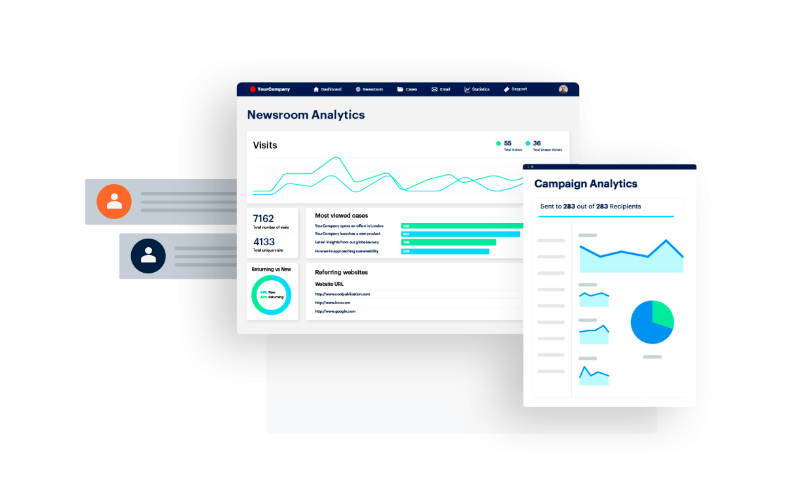
3
Analyzing the results of your activities
Measurement and evaluation of PR campaigns have never been more important. The pressure from leadership teams to measure Public Relations campaigns in hard numbers is ever-growing. While the true value of a PR campaign will never be captured in a report, today companies can use analytics to make smarter decisions about Public Relations, from defining your target audience to how we measure Public Relations results. Today, with the right PR reporting software, it’s possible to paint a much clearer picture of outcomes and impact, and it shouldn’t take eight different tools to figure it out.
The handiest approach might be to find a tool that offers integrated analytics, which is often enough to track the performance of your newsroom content and email campaigns, and look for tools with a PR distribution software guide that can be easily integrated or used on the side when needed – like Google Analytics.
Some of the basic metrics to look out for are:
- Visitors
- New vs returning visitors
- Most popular/viewed content
- Keywords
- Referral websites
- Downloaded, viewed images
- Downloaded documents
- Editorial coverage stats
While integrated PR reporting software will give comprehensive quantitative metrics, it’s up to the PR team to interpret these numbers for management, pointing out how a successfully orchestrated PR campaign helps the company reach its organizational goals. While tools and software can make life easier for the PR team, creativity, grit, and energy are still needed in abundance to make a campaign work.

4
Security and support
Your legal and IT team need to be sure that your PR tool meets all their technical and legal requirements. It’s important that all measures to keep your account safe and stable are in place, the platform works reasonably fast, and you can count on the support to make sure things run smoothly at any given time.
- Quality support: When your team is adapting to a new tool, it’s normal to have questions or run into teething problems. You should be able to ask for help and receive swift and accurate answers to your questions so your team can do their jobs with as few hiccups as possible.
- Onboarding and training: Using a new tool or platform can be overwhelming at first, so invest in a tool that offers comprehensive onboarding and training – this is a good way to make sure you get the most out of it.
- User accounts and permission levels: For bigger organizations with large PR teams, it’s good practice to have a hierarchy of user accounts and permission levels. Certain features might be made available only to managers and above, to ensure the content has gone through the proper approval channels before release.
- Secure login: Cyber security is an absolutely crucial consideration as hackers are constantly looking for vulnerabilities in large companies through which they can pose a threat. Our PR distribution software guide will help you look for features that ensure that your account will stay safe no matter where you work from – single sign-on and multi-factor authentication are considered standard.
- SSL certificate: These digital security certificates let users know they’re not on a bogus site. They ensure encrypted connections between the browser or user’s device and the server or website they’re connecting to.
- Accessibility and compliance: Many organizations are required to have an accessible website by law (including their newsroom) and the Web Content Accessibility Guidelines are the best place to see which requirements this entails and determine whether your provider will be able to fulfill them. The World Wide Web Consortium (W3C) ensures that code is built according to a set of quality standards, and they are also concerned with accessibility.
- Browser compatibility: Browser compatibility: Most people have preferred browsers, so it’s important to check that your PR reporting software will work just as well in Chrome and Mozilla Firefox as it would on Safari, Opera, or even Microsoft Edge.

5
The final decision
As always, the right choice of software will come back to your Public Relations goals. These are most often tied to managing the public image of your company. Whether that means growing the brand, managing reputation, securing share of voice, or building affinity, finding PR software with the tools you need can be a gamechanger. It will powerfully tell your stories, help you distribute them tactically, and provide insights into the esults of your activities.
But a great piece of PR content is only worthwhile if it generates the right type of coverage for your company and helps improve your reputation that’s why a PR distribution software guide is important. No matter how clever, creative, or even courageous a campaign is, you need the right tools in place to make that impact. Investing in PR software cuts out a lot of the arduous, manual busy work and lets your team focus on creating unforgettable campaigns.

PR Software checklist
Details matter. To make sure you don’t miss anything, here’s a full breakdown of all the specific features you might need in a PR software.

